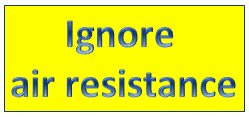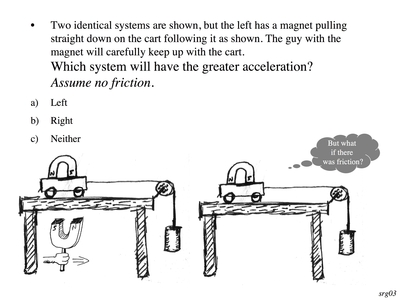F-N2-1 A force is:
- equal to mass times acceleration.
- an interaction between objects.
- dependent on the mass of an object.
- dependent on the acceleration of an object.
- dependent on the velocity of an object.
- only involving one object.
- always making objects accelerate.
F-N2-2 A ball rolls off a table at a pretty good speed and has not yet his the ground. What forces act on the ball?
A normal force, N
A tension force, T
A friction force, f
A weight, W

- Only W
- Only N
- Only T
- Only f
- No forces
- N and W
- N, W, and f
- W and f
- N and f
F-N2-3 A baseball is thrown from right field to home plate (HP), traveling from right to left in the diagram.

A group of physics students watching the game create the following free-body diagrams for the baseball at the top of its path (point T). Note that the forces are not drawn to scale.

If they decide to ignore air friction, which is the correct free-body diagram for the baseball at point T?
F-N2-4 A person who weighs 600 N is standing on a scale in an elevator. The elevator is identical in all cases. The velocity and acceleration of the elevators at the instant shown are given.

Rank the scale reading.
F-N2-5 A person throws a ball up in the air and then catches it again. Sketch the normal force of the hand on the ball over time.

F-N2-6 A box with wheels attached to bottom is on top of a horizontal scale. Attached to one side is a horizontal rope with a spring scale to measure force (assume the scale and ropes are mass-less). On the other side of the box is a rope that has no force being applied to it.
Sketch a FBD of the box

F-N2-7 A 10-kg-box with wheels attached to bottom is on top of a horizontal scale. Attached to one side is a horizontal rope with a spring scale to measure force (assume the scale and ropes are mass-less). On the other side of the box is a rope that now has a horizontal force equal to 150 N pulling on it.

Sketch a FBD of the box, attempting to scale each vector relative to each other.
F-N2-8 A 10-kg-box with wheels attached to bottom is on top of a horizontal scale. Attached to one side is a horizontal rope with a spring scale to measure force (assume the scale and ropes are mass-less). On the other side of the box is a rope that now has a force equal to 150 N pulling on it in a direction 30 degrees up from the horizontal.

Sketch a FBD of the box, attempting to scale each vector relative to each other.
What is the force the spring scale measures?
What is the force the bottom scale measures?
F-N2-9 A 10-kg-box with wheels attached to bottom is on top of a horizontal scale. Attached to one side is a horizontal rope with a spring scale to measure force (assume the scale and ropes are mass-less). On the other side of the box is a rope that now has a force equal to 150 N pulling on it in a direction up from the horizontal.

What angle, in degrees, will the box begin to lift off the ground?
F-N2-10

F-N2-11 A box on a frictionless horizontal surface is pulled at a constant rate by a rope that makes an angle up from the horizontal. If the vertical component of the force is not large enough to lift the box off the table, what is the net force, acceleration, velocity, position as a function of time?

F-N2-12 A box on a frictionless horizontal surface is pulled at a constant rate by a rope that makes an angle up from the horizontal. If the vertical component of the force is large enough to lift the box off the table, what is the net force, acceleration, velocity, position as a function of time?
